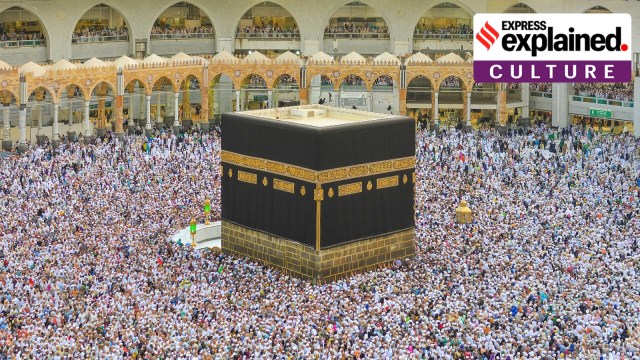Explained: The story of the Kiswah, sacred cloth that covers the Holy Kaaba in Mecca
For the first time, the full Kiswah will be displayed outside Mecca. It will be the central element of the Islamic Arts Biennale 2025 that begins in Jeddah, Saudi Arabia on January 25
 The Kaaba, covered with the black and gold Kiswah, located at the Masjid Al-Haram in Mecca, Saudi Arabia).
This photo was taken during the 2018 Hajj Season. (Wikimedia Commons)
The Kaaba, covered with the black and gold Kiswah, located at the Masjid Al-Haram in Mecca, Saudi Arabia).
This photo was taken during the 2018 Hajj Season. (Wikimedia Commons)
Among the highlights of the Islamic Arts Biennale 2025, which opens at the Western Hajj Terminal of King Abdulaziz International Airport in Jeddah on Saturday (January 25) will be the Kiswah of the Holy Kaaba in Mecca (Makkah).
This will be the first time that the full Kiswah will be displayed outside the holy city, according to a release issued by the Diriyah Biennale Foundation, which organises the Islamic Arts Biennale.
The inaugural edition of the Biennale was held in 2023. The second edition, titled ‘And All That Is In Between’, will continue until May 25. It will display, apart from the Kiswah, “a remarkable collection of historical Islamic artifacts and contemporary artworks”, and will “inspire visitors to contemplate the richness of Islamic civilisation and its creative arts”, says the release.
بعد يومين فقط، سيجتمع العالم في أكبر معرض للفنون الإسلامية!
لا تفوت هذا الحوار الفريد بين أصالة التراث وروح الإبداع في بينالي الفنون الإسلامية 2025.انضم إلينا في صالة الحجاج الغربية بمدينة جدة، من 25 يناير إلى 25 مايو 2025.
احجزوا تذاكركم!https://t.co/JWhORSUQ6S… pic.twitter.com/5ZYXIPsZKq
— Diriyah Biennale Foundation (@Biennale_Sa) January 23, 2025
The Kiswah
The Kiswah, literally “robe”, is the intricately-embroidered black cloth that covers the Kaaba, the cubical stone structure at the centre of the Masjid al-Haram in Mecca, the holiest site in Islam.
“The Kiswah and its unique inscriptions and ornamentations are considered to be the highest form of creative production in Islamic arts,” the release says.
“By exhibiting the Kiswah, the Biennale will present a unique display that introduces the artifact’s historical development and its associated craftsmanship. It enables visitors to admire its intricate weaving and embroidery, featuring silk, gold, and silver threads,” according to the release.
The Kiswah is changed every year during a special ceremony. The Kiswah that will be displayed at the Biennale is the one that adorned the Kaaba last year.
“The Kiswah display will coincide with the first Hijri centenary of the establishment of the Kiswah Factory of the Holy Kaaba (King Abdulaziz Complex) in Saudi Arabia, which has had the honour of manufacturing the Kiswah since AH 1346 (1927),” the release says.
At the conclusion of the Biennale in May, the Kiswah will return to the care of the Kiswah Factory of the Holy Kaaba (King Abdulaziz Complex), it says.
History of the Kiswah
The tradition of draping the Kiswah around the Kaaba is centuries old. The accounts of its origins vary, but according to a widely held view, the first to cover it entirely was Tabu Karab Aswad, the king of Humayyur in Yemen, in the pre-Islamic era. After the conquest of Mecca in 8 AH (629-630 CE), the Prophet covered the Kaaba with a Yemeni cloth.
According to a report (‘The Kiswa: The story behind the covering of the holy Kaaba’) published in the Saudi daily Arab News in 2020, “The accounts mention that in the conquest of Makkah, the Prophet kept the old Kiswa used in the era of the polytheists and did not replace it until a woman burned it while trying to scent it with incense. It was then covered with a Yemeni cloth. Muslim kings and sultans then continued to undertake covering the Kaaba and caring for it.”
The colours of the Kiswah have changed over the centuries. The Arab News report said: “The Prophet Muhammad covered it with white-and-red striped Yemeni cloth, and Abu Bakr Al-Siddiq, Umar ibn Al-Khattab, and Uthman ibn Affan covered it with white. Ibn Al-Zubayr covered it with red brocade.”
Abu Bakr (632-34 CE), Umar (634-44), and Uthman (644-56) were the first three Rashidun Caliphs. Ibn al-Zubayr was the leader of Muslims in Mecca during the second half of the 7th century.
“During the Abbasid era, [the Kaaba] was draped once with white and once in red, while the Seljuk Sultan covered it with yellow brocade. The Abbasid Caliph Al-Nassir changed the Kiswa’s color to green and later to black brocade, and this has remained its color to the present day,” the Arab News report said.
The Abbasid Caliphate ruled from Kufa, Baghdad, and Samarra in Iraq between 750 CE and 1258 CE. The Turko-Persian Seljuk Empire reigned from 1037-1194 CE.
By the early 14th century, Egypt had become “the official producer of the Kiswa”, according to a 2017 report by the Cairo-based publication Egypt Today.
“It was sent in a venerable parade, carried by a huge camel, followed by other camels that carry the water and the luggage of the pilgrims. They were accompanied by soldiers to protect them throughout their journey till they reach Mecca. The camel that carries the kiswa is called Nabeel, Arabic for Noble, and the next one was called Mabrouk, Arabic for Blessed,” the report, titled ‘The Egyptian legacy of producing the Kiswa’, said.
Making of the Kiswah
Weighing more than 1,000 kg, the Kiswah of today is made of silk, embroidered with gold and silver thread. It comprises four sides and a door curtain, and takes almost a year to produce. More than 100 workers are focussed solely on its embroidery.
An August 2018 report by Al Arabiya quoted Ahmad bin Mohammed Al-Mansouri, the director-general of the King Abdul Aziz Complex for the Kaaba, as saying the Kiswah “is made from about 670 kg of raw silk, which is dyed black, 120 kg of gold threads and 100 kg of silver threads”, and “is covered with cotton-lined silk, while the Quran verses are sewed with the gold and silver threads”.
A July 2024 report by the Saudi Press Agency described the 10-stage process of the manufacture of the Kiswah:
“The manufacturing process…begins with the “sweetening” of water according to specific standards for silk washing and dyeing. Next is the “dyeing” stage, where the protective wax layer is removed and the silk is dyed black for the outer covering and green for the inner covering and the Prophet’s Chamber. The silk is then dried in specialized dryers.”
In the “laboratory” stage, samples are tested before and after dyeing to ensure the silk and silver threads, and silver threads coated with gold, meet approved standards. Automated weaving converts silk threads from hanks into spools.
While a jacquard silk weaving machine creates the outer cover, plain silk fabric is also produced to print and embroider Quranic verses. Later, pieces of plain silk fabric are attached to the woven fabric. This is followed by several other stages.
Finally the Kiswah is assembled by bringing together its pieces, including the curtain and the adorned sections.
Replacing the Kiswah
“…The old Kiswa [is] replaced annually on the first day of [the first Muslim month of] Muharram. This process involves removing the designated Kiswa from each wall of the holy Ka’aba individually, securing the four pieces together at the corners and beneath the Kaaba, and then installing the curtain of the Ka’aba door,” the Saudi Press Agency report said.
After it is removed, the old Kiswah “is placed in a government warehouse providing the adequate technical conservation to prevent any chemical reactions or infiltration of bacteria in damaging the fabric”, according to the Al Arabiya report mentioned earlier.
“Then, if requested by the higher authorities, it is distributed in parts for museums or gifts,” the report said. In 1983, for example, a part of the Kiswah was presented to the United Nations by Saudi Arabia’s Ambassador to the UN, Shaikh Faisal al-Hujaylan.



- 01
- 02
- 03
- 04
- 05



































